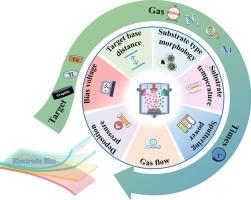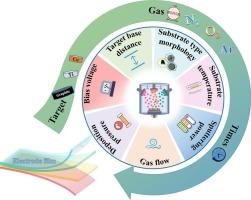磁控溅射薄膜作为超级电容器电极材料的研究
IF 13.2
1区 工程技术
Q1 ENGINEERING, CHEMICAL
引用次数: 0
摘要
超级电容器是一种先进的储能装置,自20世纪50年代 以来一直处于开发阶段,对能够显著提高超级电容器性能的新电极材料的探索从未停止。近年来,无粘结剂电极制造技术引起了研究者的广泛关注。在衬底上直接生长性能优异的电极材料是制备无粘结剂电极的一种很有前途的方法。磁控溅射作为一种物理气相沉积(PVD)技术,具有沉积速度快、易于控制等优点,制备的薄膜纯度高、耐腐蚀、均匀性好、衬底结合力强。磁控溅射技术通过在不同的衬底材料上沉积各种类型的薄膜,在超级电容器电极的制备中显示出很大的优势。本文综述了磁控溅射技术对超级电容器薄膜电极微观结构和性能调制的影响,以及近年来用磁控溅射制备的氮化/硫化物/氧化物、金属、碳基等石墨烯薄膜作为超级电容器电极材料的研究进展,最后进行了总结和展望。这对今后磁控溅射技术的发展和应用以及超级电容器的发展具有重要的参考意义。本文章由计算机程序翻译,如有差异,请以英文原文为准。


Research on magnetron sputtering thin films as electrode materials for supercapacitors
Supercapacitors are advanced energy storage devices that have been in development since the 1950 s, and the exploration of new electrode materials that can significantly improve the performance of supercapacitors never stops. In recent years, the binder-free electrode fabrication technology has attracted extensive attention from researchers. The direct growth of electrode materials with excellent performance on the substrate is a promising strategy for the preparation of binder-free electrodes. Magnetron sputtering, as a Physical Vapor Deposition (PVD) technique, has the advantages of fast deposition speed and easy control, and prepares films with high purity, corrosion resistance, good uniformity, and strong substrate bonding. Magnetron sputtering technology has shown great advantages in the preparation of supercapacitor electrodes by depositing various types of thin films on different substrate materials. In this paper, the influence of magnetron sputtering technology on the microstructure of supercapacitor thin film electrodes and the modulation of the performance are reviewed, as well as the study of nitride/sulfide/oxide, metal, and carbon-based, such as graphene, thin films prepared by magnetron sputtering as supercapacitor electrode materials in recent years, and then finally summarized and outlooked, which is an important reference significance for the development and application of the magnetron sputtering technology in the future as well as for the development of supercapacitors.
求助全文
通过发布文献求助,成功后即可免费获取论文全文。
去求助
来源期刊

Chemical Engineering Journal
工程技术-工程:化工
CiteScore
21.70
自引率
9.30%
发文量
6781
审稿时长
2.4 months
期刊介绍:
The Chemical Engineering Journal is an international research journal that invites contributions of original and novel fundamental research. It aims to provide an international platform for presenting original fundamental research, interpretative reviews, and discussions on new developments in chemical engineering. The journal welcomes papers that describe novel theory and its practical application, as well as those that demonstrate the transfer of techniques from other disciplines. It also welcomes reports on carefully conducted experimental work that is soundly interpreted. The main focus of the journal is on original and rigorous research results that have broad significance. The Catalysis section within the Chemical Engineering Journal focuses specifically on Experimental and Theoretical studies in the fields of heterogeneous catalysis, molecular catalysis, and biocatalysis. These studies have industrial impact on various sectors such as chemicals, energy, materials, foods, healthcare, and environmental protection.
 求助内容:
求助内容: 应助结果提醒方式:
应助结果提醒方式:


